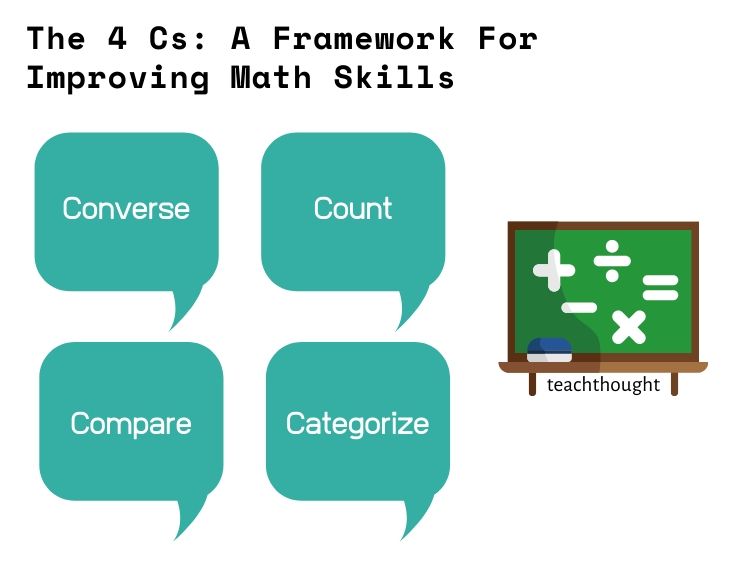
Improving Math Skills With The 4 Cs Framework
contributed by Anastasia Betts, VP Curriculum Planning and Design at Age of Learning
The U.S. is lagging behind in math literacy.
According to the Program for International Student Assessment (PISA), American teens are well below standard proficiency in math. However, the breakdown in math literacy occurs during early childhood, well before the teen years.
Research has shown that early development of math skills and knowledge strongly predicts later math achievement. According to recent data from the creators of ABCmouse, Age of Learning, nearly 70% of parents are incorrectly assuming their child is spending the necessary amount of time they need, in and out of school, engaged in math-based learning to be proficient. Moreover, most homes focus on helping young children learn to read and write their numerals, while other types of math activities may provide more benefit.
The key to improving the home math environment for young children is to move beyond simple counting exercises. The ‘Four Cs’ is a strategy designed to help parents remember the activities most useful to young children when learning math.
The Four Cs stand for Converse, Count, Compare, and Categorize, each of which is critical to the development of a young child’s mathematical knowledge. This strategy can improve the quality of parent-child math discussions and, through targeted conversation, help children develop the vocabulary needed for a solid mathematics foundation.
Converse
Talking to children about numerical concepts is crucial, as it helps to build not only their math vocabulary but also their knowledge of and curiosity about math concepts.
Conversations should center around everyday activities that relate to the child’s lived experiences (e.g., skipping rope, taking a walk in the park, doing activities around the house). Children are likely to be more engaged and connect more with these activities than with more formal activities (e.g., workbooks, etc.).
Use questions to drive the conversation and encourage your child’s use of strategies for critical thinking. It’s relatively easy for parents to introduce math conversations into daily activities with their children. Asking how many, which has more or less, which is taller, shorter, or bigger, which items ‘go together’ or belong in the same group, are all great conversation starters. Perhaps most importantly, parents should ask children why they think something is true, or how can you show that this is true?
For example, when comparing different items, parents can ask how you know this group has more than that group? How can you show that your idea is true?
Count
Research continues to show that various counting experiences are vital to developing children’s strong number sense. Counting means more than just saying the number sequence, as it can refer to reciting the count sequence, counting the total number of objects in a pile, counting out a certain number of items from a pile, or counting on a few more to an existing group of items. It can also mean counting forward and backward from a given number.
It’s important for parents and caregivers to develop an awareness of the different types of counting experiences they can share with their children, and look for opportunities to do more than just recite or recognize numbers (e.g., counting apples to buy from the grocery store, sharing out 10 grapes each for lunch, etc.).
Compare
Comparing is an important skill that underpins much of mathematics and other sciences as well. Helping young children realize that many attributes can be observed and compared helps prepare them for more sophisticated math concepts that will come later. Parents should invite children to think about the characteristics that different objects possess, such as color, shape, position, and more (e.g., this one is darker blue, this one is lighter blue; this one has more, this one has less; this one has four sides, that one has only three).
Quantity is also an attribute that children must come to understand and recognize, as it is a critical milestone in a young child’s mathematical foundation (e.g., who has more grapes? You or me? How do you know? Etc.).
One way to build and strengthen a child’s ability to compare is through the use of puzzles. Puzzles provide ideal opportunities to help children think critically about comparisons; as the child examines the puzzle pieces to see where they should be placed, children observe color, pattern, and shape. These early observations and comparisons prepare children for the critical thinking they will do later on in math and science.
Categorize
There are many opportunities in everyday activities for children to categorize and sort. Children can organize a bookshelf according to shape and size, organize the pantry by food type, helping fold the laundry and sorting by clothing type, load or unload the dishwasher or dish rack, etc. Understanding the characteristics that make something belong (or not belong) to a group is an important part of their mathematical foundation (e.g., all of these shapes are rectangular and triangular, etc.).
Parents and children can have so many rich mathematical experiences together. The Four Cs provides a simple way to help build parent awareness of these activities. Using the Four Cs, parents can incorporate daily math experiences that move beyond simple rote counting to the more advanced early math experiences that lead to success in school mathematics and beyond.